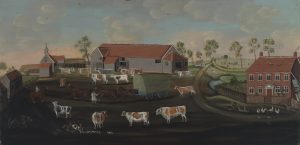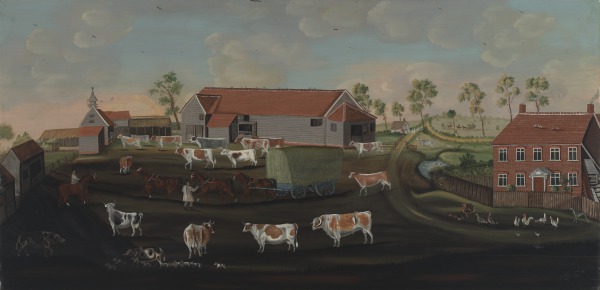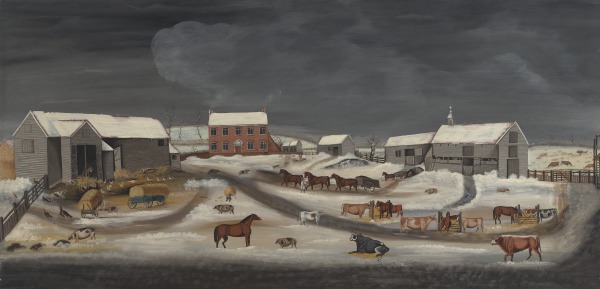
Lesson Concept: William Williams
A landscape is a picture of natural scenery that includes landforms, trees, flowers, weather, and the other elements within a particular environment. Art depicting British country life, including sporting activities, served as historical documentation of a particular time period and way of life.

Farm Scene in Summer, 1802
W. Williams (English, active 1802)
Oil on panel, 287/8 x 581/8 in.; 283/4 x 591/2 in.
Gift of Mr. and Mrs. Paul Mellon

Farm Scene in Winter, 1802
W. Williams (English, active 1802)
Oil on panel, 287/8 x 581/8 in.; 283/4 x 591/2 in.
Gift of Mr. and Mrs. Paul Mellon
Farm Scene in Summer and Farm Scene in Winter
Although there were numerous artists called William Williams active in England at the end of the eighteenth century, little is known about the “W. Williams” who signed these two paintings in VMFA’s Mellon Collection. Because of the subjects he painted, it is presumed he was English and, judging by the perspective of the paintings, he may have been a self-taught artist who may have painted scenes from his own farm.
The summer and winter landscapes might depict Suffolk, England: the Georgian style of architecture (original to England), the smocks worn by the farmworkers, and the “corn hole” on the central barn in the summer scene all seem to indicate an English setting. Georgian houses were generally square, two-story brick structures with a central door and dormers. (A dormer is a window that sticks out from a sloping roof.) Usually, there was the same number of windows on each side of the house and a chimney either directly in the center of the house or on each end. The windows circulated air in summer and the chimneys provided warmth in winter.
In these landscapes the same farm is shown from two different perspectives and in two seasons, providing many visual clues about farm management during the early nineteenth century. Farmers often built houses and stables near springs to supply water for the family and the animals. The summer landscape portrays many farmhands working in the fields and near the barns. Also, there is a small pond with ducks. Notice the activity of the animals in summer versus winter and the differences in the land itself. In the summer scene the animals are grazing, whereas in the winter scene they are feeding on the grain that was harvested in the summer. Not only is there new growth in the summer months, there is new life: piglets are depicted trotting in the foreground. Some farm animals provided foods such as meat, milk, and eggs; others worked in the fields pulling plows. Their manure, seen steaming in a large pile in the winter scene, was used for fertilizer. Horses pulled wagons with goods and carriages with people to and from a city or town. This particular farm has several different varieties of livestock, including turkeys, chickens, horses, cows, pigs, and oxen.
Rural families during this time were frequently large. Children helped their parents in the house and in the fields. Fathers often did seasonal work in the fields and practiced trades such as blacksmithing or carpentry in the winter. Many of the farmhands in these paintings were likely family members, some as young as seven years old. Mothers raised children; tended the household, kitchen garden, and dairy; and made the family’s clothes. Children learned to make their own clothes by age four, and most young boys between the ages of seven and nine would begin apprenticeships in skilled trades. Surplus produced by the family was traded for things the family could not make itself.
Ideas for Grades K-2
Discussion
Use the following suggested questions and discussion points while looking at Farm Scene in Summer and Farm Scene in Winter:
- Observe and describe what is visually represented in each picture using art vocabulary. (Identify shape, color, form, line, etc.)
- Find Suffolk, England, on a map.
- Define a landscape painting.
- List the different animals in the two landscapes.
- Describe the different sounds, smells, and textures that would be on this farm.
- Talk about the variety of resources farm animals would provide for a rural Georgian-era English family as well as a modern family.
- Compare and contrast the seasonal differences illustrated in the two paintings.
- Discuss the seasonal differences in nature in summer, fall, winter, and spring.
- Relate the lifestyle of a family that may have lived on this farm to that of a modern family. How are they alike? How are they different?
Activities
ACTIVITY 1
Have students cut or tear a variety of brown and green textured paper into squares and rectangles and glue them onto a larger piece of paper in a pattern resembling an aerial view of a farm. Ask them to draw and cut out animals to glue on their farm together with resources the animals would need to live.
ACTIVITY 2
Have students create a series of four mixed-media drawings depicting the changing of the four seasons.
ACTIVITY 3
Show students how to create a series of prints and rubbings using imitation or natural objects characteristic of each season.
Encourage the students to share their ideas about what they produced!
Standards of Learning
Visual Arts: K.1, K.2, K.3, K.5, K.7, K.9, K.11, K.13, K.14, 1.1, 1.2, 1.8, 1.9, 1.10, 1.11, 1.12, 1.13, 1.14, 1.16, 1.17, 1.18, 1.19, 2.4, 2.5, 2.7, 2.9, 2.17, 2.18, 2.21
English: K.1, K.2, K.3, K.5, 1.1, 1.2, 2.2 History K.2, K.3, K.4, K.5, 1.4, 1.6, 1.7, 2.3, 2.7, 2.9
Science: K.1, K.2, K.4, K.6, K.9, 1.5, 1.7, 2.6, 2.7, 2.8
Ideas for Grades 3–5
Discussion
Use the following suggested questions and discussion points while looking at Farm Scene in Summer and Farm Scene in Winter:
- Observe and describe what is visually represented in each picture using art vocabulary. (Identify shape, color, form, line, etc.)
- Find Suffolk, England, on a map.
- Explain the historical significance of art representing English country life.
- Outline daily activities and chores that may take place on a farm similar to the one depicted here.
- Describe the agricultural season and processes from beginning to end.
- Identify different seasons and weather represented in each scene.
- List the resources needed to maintain a farm such as this one.
- Talk about the variety of resources farm animals would provide for a rural Georgian-era English family as well as a modern family.
- Discuss the seasonal differences in nature in summer, fall, winter, and spring.
- Relate the lifestyle of a family that may have lived on this farm to that of a modern family. How are they alike? How are they different?
Activities
ACTIVITY 1
Have students make a single-fold book in which they will create an illustrated diary as if they were being raised on an English farm in the early nineteenth century.
ACTIVITY 2
Have students paint a series of landscapes depicting their homes in each season.
Encourage the students to share their ideas about what they produced!
Standards of Learning
Visual Arts: 3.6, 3.7, 3.8, 3.9, 3.11, 3.13, 3.14, 3.18, 3.19, 3.20, 3.22, 3.23, 4.1, 4.2, 4.4, 4.5, 4.7, 4.14, 4.18, 4.22, 4.23, 5.1, 5.3, 5.5, 5.13, 5.18, 5.19, 5.21, 5.22, 5.23
English: 3.1, 3.2, 3.9, 3.10, 3.11, 4.1, 4.7, 4.8, 5.2, 5.3, 5.8, 5.9
History: 3.5, USI.5
Science: 3.8, 4.4, 4.7, 4.8

